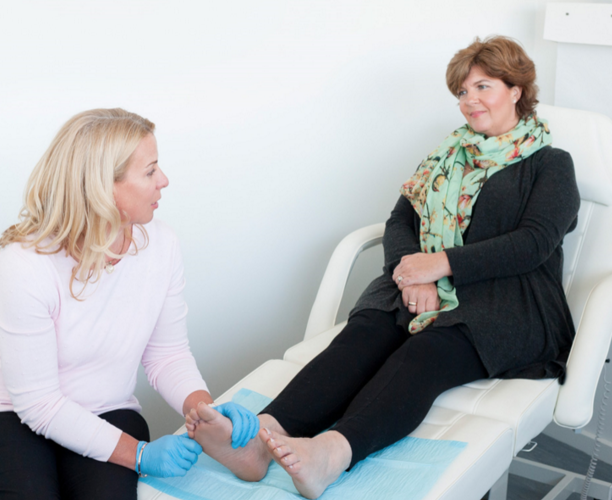Ingrown Toenail Treatment Melbourne
An ingrown toenail occurs when the edge of a toenail grows into the surrounding skin, leading to pain, swelling, and potential infection. This condition can be caused by various factors, including improper nail trimming, wearing tight shoes, injury, or genetic predisposition.

What are the most common treatments provided by podiatrists for ingrown toenails?
Podiatrists regularly treat ingrown toenails, a common foot problem, with various approaches depending on the severity of the condition. Common treatments they may provide for ingrown toenails include:
Initial Assessment:
Podiatrists conduct a thorough examination of the ingrown toenail to assess its severity, the presence of infection, and potential contributing factors. This evaluation helps determine the most appropriate course of action.
Conservative Management:
Soaking: Mild cases of ingrown toenails may be treated with warm water soaks, usually mixed with Epsom salts, to reduce inflammation and infection risk.
Proper Trimming: Podiatrists can demonstrate the correct way to trim toenails, emphasising straight across rather than rounded edges to prevent ingrowth.
Oral Antibiotics:
If the ingrown toenail is infected, your endorsed podiatrist may prescribe oral antibiotics to clear the infection. Antibiotics may be used in conjunction with other treatments.
Nail bracing
For ingrown toenails that are not suitable for surgical intervention, podiatrists often perform a nail bracing procedure that works on widening the nail plate. Please click the link to see how this is done.
Complete Nail Removal (Total Nail Avulsion):
In very severe or recurrent cases, podiatrists may recommend completely removing the affected toenail. This procedure is typically reserved for extreme cases or when other treatments have been unsuccessful.
After the nail is removed, the nail matrix may also be treated to prevent future nail regrowth.
Chemical or Phenolisation Procedure:
Following a partial or complete nail removal, podiatrists may use a chemical (typically phenol) to destroy the nail matrix tissue. This is done to ensure that the ingrown portion of the nail does not regrow.
The chemical is applied directly to the nail matrix, effectively stopping regrowth in that area. It may also help prevent ingrown nails from returning.
Education and Prevention:
Podiatrists educate patients on proper foot hygiene and nail care practices to prevent the recurrence of ingrown toenails. This includes guidance on proper nail trimming techniques and suitable footwear.
Ongoing Monitoring:
After treatment, podiatrists may schedule follow-up appointments to monitor the healing process and ensure that the ingrown toenail does not return. They may provide additional recommendations based on the individual’s response to treatment.
Podiatrists will assess the severity of the ingrown toenail and consider your overall health and any potential underlying causes when determining the most appropriate treatment option. In many cases, conservative management and proper toenail care can alleviate the problem. However, for more severe or recurrent cases, minor surgical procedures like partial nail removal or chemical treatments may be recommended to provide long-lasting relief from ingrown toenails.
If you suspect you have an ingrown toenail or are experiencing pain, it’s essential to seek professional care from a podiatrist to prevent complications and obtain effective treatment.
What causes ingrown toenails?
Ingrown toenails can be caused by various factors, including improper nail trimming, wearing tight shoes, trauma to the toenail, and genetic predisposition. Ingrown toenails occur when the edge of the toenail grows into the surrounding skin, leading to pain and potential infection.
Can I continue with regular physical activities after ingrown toenail treatment?
It depends on the severity of the condition. In mild cases where conservative measures, such as warm soaks and proper toenail care, are sufficient, individuals may be able to maintain their regular physical activities. However, in more severe cases requiring medical intervention or surgical procedures to address the ingrown toenail, it may be advisable to temporarily modify activities to allow for proper healing and avoid exacerbating the condition.
How can I prevent ingrown toenails?
To prevent ingrown toenails, practice proper nail care by trimming nails straight across, avoiding rounded edges. Wear shoes that provide enough room for your toes, and choose breathable footwear. Keep your feet clean and dry, and be cautious when cutting your nails to avoid injury.
When should I see a podiatrist for an ingrown toenail?
It’s advisable to see a podiatrist if you experience persistent pain, redness, swelling, or signs of infection around the toenail. If home care measures are not providing relief or if you have recurrent ingrown toenails, seeking professional help is recommended.
Is ingrown toenail removal painful?
The level of discomfort during ingrown toenail removal can vary. For minor cases or conservative treatments, the discomfort is usually minimal. More advanced procedures, such as partial or total nail avulsion, may involve local anesthesia to minimize pain during the procedure.
How long does it take for an ingrown toenail to heal after treatment?
The healing time depends on the severity of the ingrown toenail and the treatment provided. Conservative measures may lead to improvement in a matter of days, while surgical procedures may require a longer recovery period. Follow your podiatrist’s instructions for post-treatment care.
Always Consult A Trained Professional
The information in this resource is general in nature and is only intended to provide a summary of the subject matter covered. It is not a substitute for medical advice and you should always consult a trained professional practising in the area of medicine in relation to any injury or condition. You use or rely on information in this resource at your own risk and no party involved in the production of this resource accepts any responsibility for the information contained within it or your use of that information.
